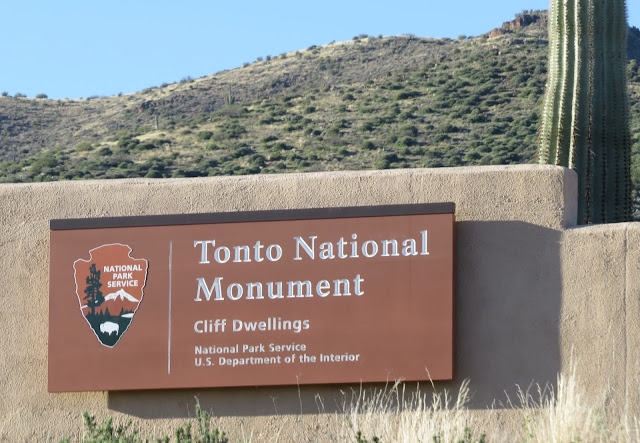There are two cliff dwellings at this site, named Upper and Lower, but there are few places below where you can see both at once.
This photo in the Visitor's Center was taken by a ranger from atop a hill somewhere in the park inaccessible to the public.
There is a viewpoint on AZ-188 from which you can see the Upper Cliff Dwelling, but the Lower is hidden behind hills.
You can only visit the Upper Cliff Dwelling on a ranger-guided hike on certain days.
I didn't do it because the tours were booked for the time I was here and I decided not to extend my stay.
I did hike to the Lower Cliff Dwelling, accessible by a paved trail from the Visitor's Center, and open every day.
You can see the Lower Cliff Dwelling from the Visitor's Center parking lot. (Upper left in the photo)
The trail winds up the mountain by way of a series of switchbacks.
I like that the entire trail is non-smoking...no cigarette butts up there! You don't see that very often.
Interpretive signs along the trail describe what life was like for the ancient Salado people who built these cliff dwellings.
The Salado people were groups of Pueblo Indians who live along the Salt River.
The Salado people were farmers and grew corn, beans, and squash in the valley below, irrigated by the Salt River and nearby springs. The lake, of course, was not there at the time.
They were also hunters and gatherers and utilized the desert plants growing on the hillside for food and many other uses.
This Canyon Towhee and many other birds can be seen and heard as we climb the trail.
Views from the trail...
Evidence has been found within the park that the Salado also built small field houses to use while tending their fields.
Getting closer.
Wildflowers along the trail.
Ginger coming up the trail.
This compares the Cliff Dwelling from before protection was in place in the 1930s. A lot of the building and artifacts have been lost to early visitors and vandals.
One more switchback.
How the cave was formed...
How the cliff Dwellings were built. It's amazing that the original wood was preserved due to the dry climate and shelter of the cave.
What to look for...
This shows where the original entrance was located.
There were about 20 rooms in the Lower Cliff Dwelling, some of them second story.
The modern entrance:
Ginger doesn't know I took this picture, haha.
The stone walls were covered with a mud adobe.
Some areas are too fragile to enter.
The wood formed the base for a second-story room.
Original wood supports and roofs have been preserved in this dry climate.
These second-story walls have been supported and reinforced.
A ranger is there to answer questions.
Many artifacts, like the metate seen here, were recovered from this site. A lot of them are on display in the Vistitor's Center museum.
You can still see fingerprints of those who applied the mud adobe on the walls.
View from inside the Cliff Dwelling.
Smoke from their fires can still be seen on the walls and ceiling.
Original ceiling...amazing.
Smoke smudges on the ceiling.
Starting back down.
On the way back down we noticed another adobe wall in the cliff.
The ranger at the Visitor's Center said it is considered an annex...one room, perhaps housing a single family, needed as the community grew. It is difficult to get to and not open to the public.
Mexican Poppies
This is the trailhead to the Upper Cliff Dwelling....next time.
Some of the artifacts in the museum. The Salado people were talented weavers.
Sandals woven from agave fiber.
Some of the tools found in the Cliff Dwellings...
These are agave knives, made of stone and used to dig agave and strip off outer leaves to get to the heart which was roasted.
When stripped off agave leaves, agave spines made already-threaded needles.
Examples of Salado pottery.
This is a pot rest, made of yucca leaves and used to stabilize a pot on the floor or to balance it on one's head for carrying.
The next day, Thistle and I went kayaking in Roosevelt Lake.
We found another vantage point from which to see both Cliff Dwellings at the same time. Lower right and upper left, but we are pretty far away.
There is a lot to see in this area of Arizona...worthy of another visit.
And I leave you with the full moon rising...


































































